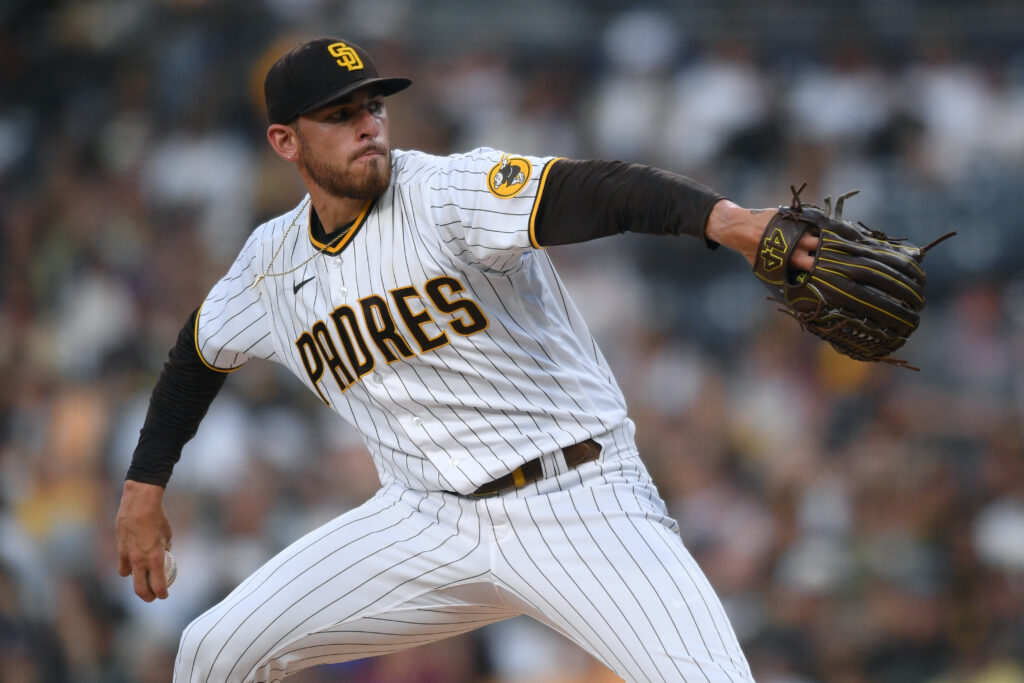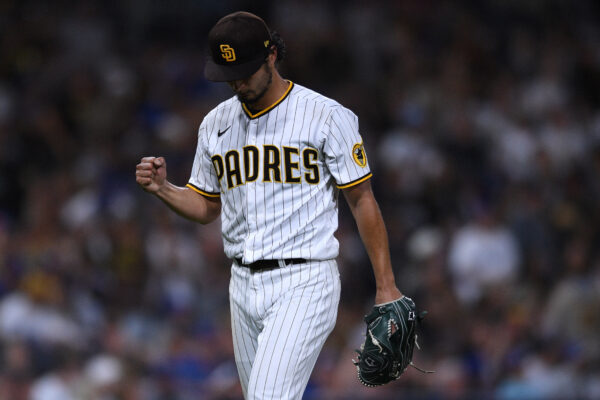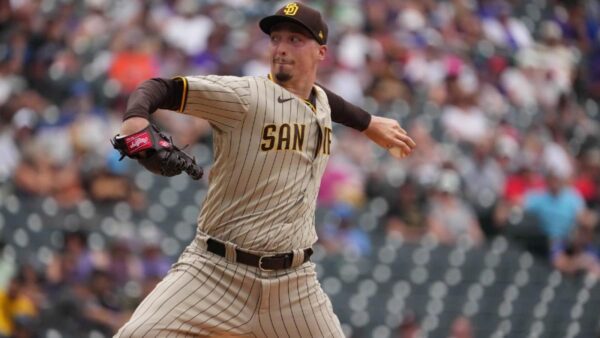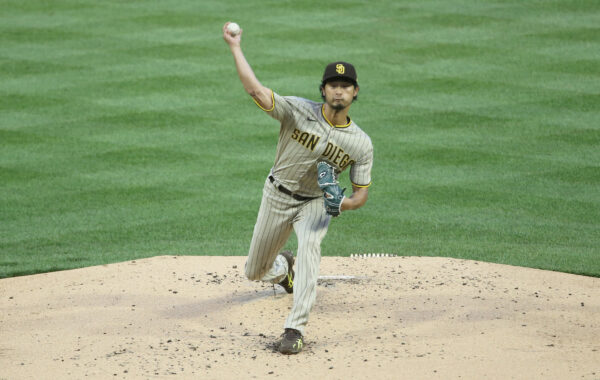Previewing the rotation for the 2022 San Diego Padres

Mandatory Credit: Orlando Ramirez-USA TODAY Sports

Entering the 2021 season, the San Diego Padres had the most anticipated starting pitching rotation in franchise history.
Two top-five finishers for the National League Cy Young Award in Yu Darvish and Dinelson Lamet, the 2018 American League Cy Young Award winner in Blake Snell, a highly touted breakout candidate in Joe Musgrove, and a former Rookie of the Year candidate in Chris Paddack, all being backed up by three top left-handed prospects in Mackenzie Gore, Ryan Weathers and Adrian Morejon.
To say things didn’t go as planned would be an understatement. Lamet dealt with injuries nearly all season, Morejon tore his UCL, Darvish, Snell, and Paddack underperformed, Weathers proved ineffective against MLB hitting, and Gore’s command faltered in Triple-A. The only success story out of the group was Musgrove, who had a breakout season and cemented his place as a top starter in the MLB.
With all that said, there’s a reason for Padres fans to be optimistic for 2022. For starters, the team has hired the highly regarded Ruben Niebla out of Cleveland to be their pitching coach for the 2022 season. Niebla has drawn plenty of praise for former Cleveland pitchers, such as two-time American League Cy Young Award winner Corey Kluber, who largely credited Niebla for helping him develop his signature two-seam fastball. Niebla will have plenty of talent to work with in San Diego and is already familiar with the returning Mike Clevinger, another beacon of hope.
Clevinger will be returning to the mound after undergoing Tommy John Surgery in November of 2020. While it’s unclear how Clevinger will look post-surgery, his impressive track record as a frontline starter would be a massive boost to the pitching staff if he can regain that form.
A deeper look into the numbers put up by staff members suggests they could see bounce-back years in 2022, as Yu Darvish and Blake Snell both posted FIPs significantly lower than their ERAs while posting high K/9s in 2021, a common trend among breakout and bounce back candidates. Chris Paddack‘s FIP at 3.78 was far lower than his 5.07 ERA, suggesting he was a victim of bad luck in 2021.
Along with the return of Clevinger, the Padres will be adding another arm to the rotation in Nick Martinez, who signed a four-year deal with the club that is still pending a physical. While it can be hard to project pitchers coming over from Japan in the MLB, Martinez was completely dominant in 2021 and features legitimate big-league pitches, which bodes well for his chances in 2022.
Let’s take a look at the options the Padres have for their 2022 rotation:
| Throws: Right | 6’5 230 pounds
2021 Stats: 181.1 IP, 3.18 ERA, 3.70 FIP, 1.081 WHIP, 7.0 H/9, 1.1 HR/9, 2.7 BB/9, 10.1 K/9, 3.5 bWAR, 3.3 fWAR
After years of flashing his frontline potential, Joe Musgrove finally achieved his long-awaited breakout in 2021.
Musgrove’s fastball sits anywhere from 90 to 96 mph, often mixing in his lower 90s cutters and sinkers with his 93-96 mph four-seam. Musgrove occasionally mixes in an 85-87 mph changeup to left-handed hitters. The main stars of Musgrove’s arsenal are his slider and curveball, two similar-looking pitches in the 80-86 mph range with slightly different breaks. His curveball features a sharp 12-6 break, while his slider features a more horizontal break. Musgrove’s breakout was fueled by increased use in these two pitches, with his slider being rated as the second most effective in baseball among starting pitchers according to Fangraphs’s Stuff+, with only Jacob DeGrom’s being rated ahead of his.
Musgrove finally reached his high potential and put up numbers that his peripherals had suggested he was capable of for years. Expect him to sit atop the Padres rotation come Opening Day and put up numbers of a number one or two starter.
Blake Snell
| Throws: Left | 6’4 225 pounds
2021 Stats: 128.2 IP, 4.20 ERA, 3.82 FIP, 1.321 WHIP, 7.1 H/9, 1.1 HR/9, 4.8 BB/9, 11.9 K/9, 1.3 bWAR, 2.1 bWAR
After struggling heavily with walks in the beginning of the season, Snell was able to dramatically turn his season around in the second half following some noticeable changes.

Snell sits 93-98 mph with his powerful fastball, pairing it with two great breaking balls in his 85-90 mph slider and 78-82 mph curveball. Snell also featured a changeup around 88-90 mph but drastically unincorporated the pitch from his mix in the second half. Snell’s improved play came after he simplified his approach in the second half. Snell began to work much quicker on the mound and used a simplified approach on the mound. Snell began attacking hitters high with his fastball and attacking the lower glove side corner with his slider, dropping in his slower curveball at the bottom or just below the zone late in counts to catch hitters off balance. In 16 starts in the first half of 2021, Snell pitched to a 4.99 ERA and 1.550 WHIP, with opponents hitting .239/.349/.419/.768 off of him. Following his second-half changes, Snell pitched to a 3.24 ERA and 1.046 WHIP in 11 second-half starts, with opponents hitting .180/.273/.315/.588 off of him.
Perhaps most importantly, in a string of six starts from August 8 to September 7, Snell was able to go seven innings or more in four of those starts. Snell pitched a combined 28.2 IP in those four, giving up 6 H, 3 ER, 7 BBs, and notching 44 Ks. Snell had been notorious for not going deep into his starts before 2021, so to say this stretch of starts is encouraging is an understatement.
Should Snell carry his second-half improvements into 2022, he can be relied upon as a solid number 2 starter behind Joe Musgrove.
[wpedon id=”49075″ align=”right”]
Yu Darvish
| Throws: Right | 6’5 220 pounds
2021 Stats: 166.1 IP, 4.22 ERA, 3.90 FIP, 1.094 WHIP, 7.5 H/9, 1.5 HR/9, 2.4 BB/9, 10.8 K/9, 1.3 bWAR, 2.9 fWAR
Yu Darvish’s 2021 was the exact opposite of Snell’s, struggling heavily in the second half after earning an All-Star appearing in his stellar first half.

Darvish throws a wide array of pitches. His four and two-seam fastballs sit in the 93-98 mph range, and his primary pitch, a cutter, sits anywhere from 84-88 mph. Among his secondary pitches, his 80-84 mph slider, 77-81 mph 12-6 curveball, and high 80s splitter are among the most notable.
Darvish had great peripherals despite his high ERA, with only his 1.5 HR/9 seemingly playing a part in its inflation. Many factors have been attributed to Darvish’s poor second-half performance, such as struggling to adjust to MLB’s foreign substance ban and recurring injuries. While those may have both factored in, there is one glaring issue that can be addressed this offseason: the regression of his cutter. In 2019, opponents slugged .341 against Darvish’s cutter and then slugged .398 against it in 2020, with Darvish understandably adopting it as his most thrown pitch during that period. So what did opponents slug against Darvish’s new go-to pitch in 2021? .624. No, that is not a mistake, a .624 opponent slugging percentage against his most thrown pitch, nearly double what it was the previous two years. Is it any wonder why Darvish collapsed in the second half?
Darvish would be better off in 2022 throwing his cutter, a pitch he threw 34% of the time, much less frequently. His sinker, slider, and curveball, which he threw a combined 39.2% of the time, should all see a bump in usage. In 2021, opponents only slugged .333 against Darvish’s sinker, .327 against his slider, and .179 against his curveball.
Darvish will need to make some improvements heading into 2022 but has shown the ability to be a possible frontline starter along with Musgrove, Snell, and Clevinger.
PAGE 2 LINK BELOW
Born and raised in San Diego, aspiring Baseball Journalist and lifelong fan of the San Diego Padres. My life’s goal is to retire early, become a season ticket holder and practically live at Petco Park in the summer.